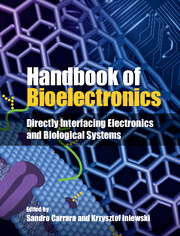Book contents
- Frontmatter
- Contents
- List of Contributors
- 1 What is bioelectronics?
- Part I Electronic components
- Part II Biosensors
- Part III Fuel cells
- Part IV Biomimetic systems
- Part V Bionics
- 22 Introduction to bionics
- 23 Bioelectronic interfaces for artificially driven human movements
- 24 The Bionic Eye: a review of multielectrode arrays
- 25 CMOS technologies for retinal prosthesis
- 26 Photovoltaic retinal prosthesis for restoring sight to the blind
- Part VI Brain interfaces
- Part VII Lab-on-a-chip
- Part VIII Future perspectives
- Index
- References
24 - The BionicEye: a review of multielectrode arrays
from Part V - Bionics
Published online by Cambridge University Press: 05 September 2015
- Frontmatter
- Contents
- List of Contributors
- 1 What is bioelectronics?
- Part I Electronic components
- Part II Biosensors
- Part III Fuel cells
- Part IV Biomimetic systems
- Part V Bionics
- 22 Introduction to bionics
- 23 Bioelectronic interfaces for artificially driven human movements
- 24 The Bionic Eye: a review of multielectrode arrays
- 25 CMOS technologies for retinal prosthesis
- 26 Photovoltaic retinal prosthesis for restoring sight to the blind
- Part VI Brain interfaces
- Part VII Lab-on-a-chip
- Part VIII Future perspectives
- Index
- References
Summary
Introduction
The notion of creating artificial vision using visual prostheses has beenwell represented though science fiction literature and films. When we thinkof retinal prostheses, we immediately think of fictional characters like TheTerminator scanning across a bar to assess patrons for appropriately fittingclothing, or Star Trek’s Geordi La Forge with his VISOR, a visualinstrument and sensory organ replacement placed across his eyes and attachedinto his temples to provide him with vision. Such devices are no longerfarfetched. In the past 20 years, significant research has been undertakenacross the globe in the race for a “Bionic Eye”. Advances inBionic Eye research have come from improvements in the design andfabrication of multielectrode arrays (MEAs) for medical applications. MEAsare already commonplace in medicine with use in applications such as thecochlear device, cardiac pacemakers, and deep brain stimulators whereinterfacing with neuronal cell populations is required.
The use of MEAs for vision prostheses is currently of significant interest.For the most part, retinal prostheses have dominated the research landscapeowing to the ease of access and direct contact to the retinal ganglion nervecells. However, MEAs are also in use for direct stimulation into the opticnerve [1]. Retinal prostheses bypass the damaged photoreceptor cells withinthe retina and instead replace the degenerate retina with electricalstimulation to the nerve cells. Using electrical stimulation, stimulatedretinal ganglion cells have been shown to elicit a percept in the form of aphosphene in blind patients [2–6]. Accordingly, the two diseasescommonly linked to the justification for Bionic Eye research are age-relatedmacular degeneration (AMD) and retinitis pigmentosa (RP), diseases whichlead to progressive loss of photoreceptor cells and diseases where thepatient has had previous vision and thus exhibits prior visual-brainpathways. At present, there has been no reliable cure for any of the retinaldiseases that target the photoreceptor cells, and thus the development ofprosthetic devices is a viable clinical treatment option [7–9].
Information
- Type
- Chapter
- Information
- Handbook of BioelectronicsDirectly Interfacing Electronics and Biological Systems, pp. 294 - 312Publisher: Cambridge University PressPrint publication year: 2015
References
Accessibility standard: Unknown
Why this information is here
This section outlines the accessibility features of this content - including support for screen readers, full keyboard navigation and high-contrast display options. This may not be relevant for you.Accessibility Information
- 1
- Cited by
